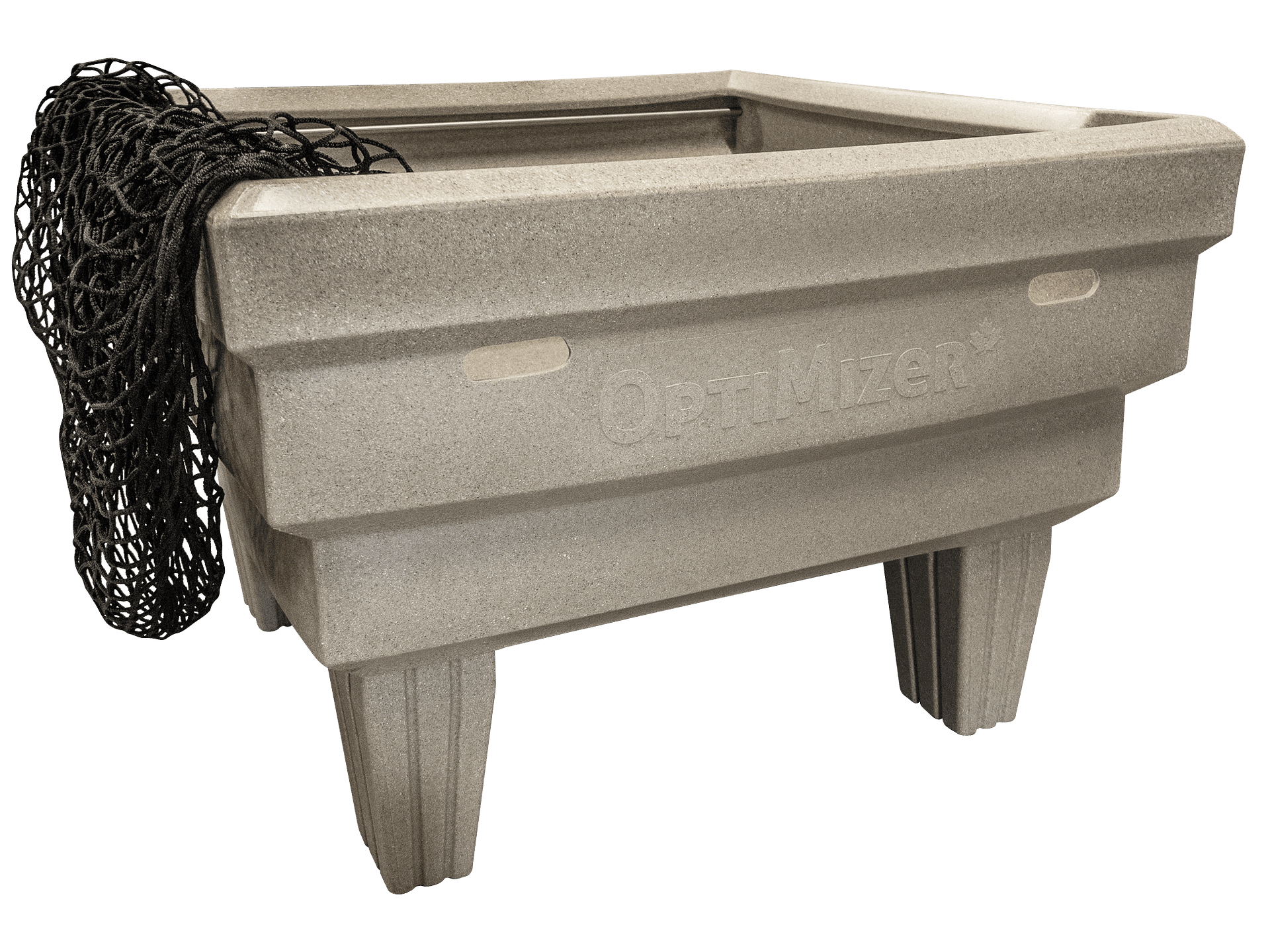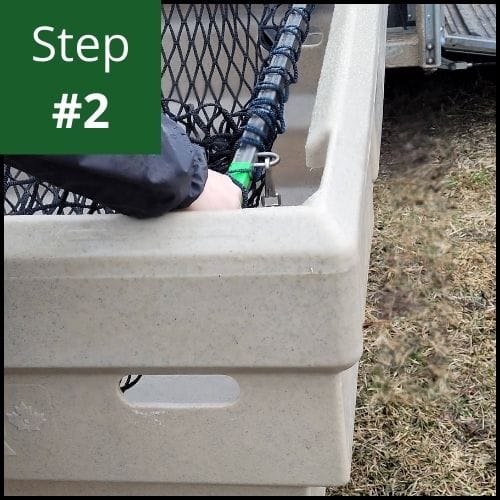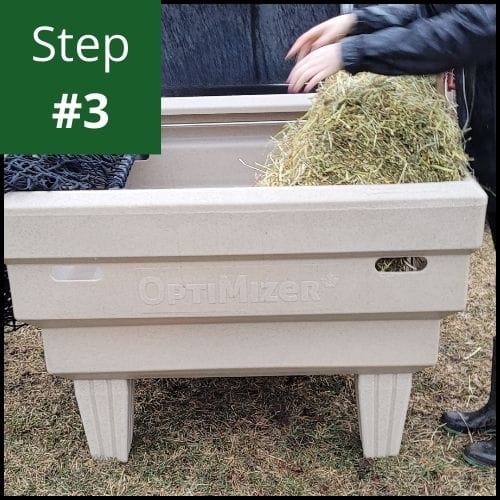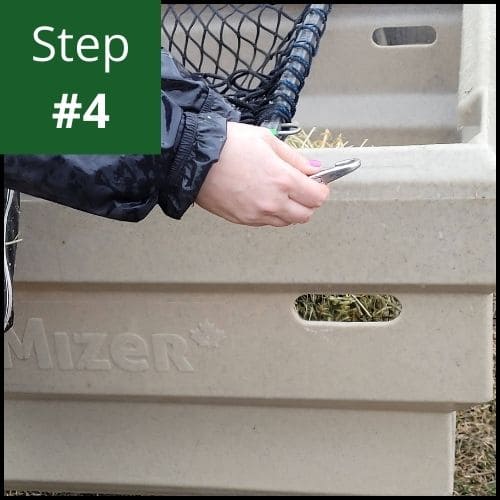About the
Paddock OptiMizer
Have peace of mind that hay is always available.
We designed the OptiMizer to make feeding hay better for horses and humans. It’s easy and quick to fill with enough hay so that horses can slowly eat clean hay for a day or two. The OptiMizer has been available since 2019 and is safely used by thousands of horses across North America.
Less than 1% of hay fed in an OptiMizer is wasted on the ground.

How Does It Work?

Unclip latch

Slide net left

Add hay

Slide net right and clip
It really is that easy.
Features
- The OptiMizer can hold two small square bales (up to 42″ long and 16″ tall) or up to 150 pounds of hay from 3-string bales, large squares, or round bales.
- The manger and legs are made of the same durable polymer used to make playground equipment (LLDPE). All the corners are rounded or bevelled, making the surfaces smooth for safety.
- OptiNet slow feed netting has been designed specifically for equine use. It’s knotless, thick, and durable, yet it’s gentle on horses’ mouths and teeth.
- The netting is held in place over the hay on a stainless steel assembly. It hangs inside the feeder and drapes over the hay from the top to the bottom as the hay is slowly consumed.
- Smooth, one handed operation of the slide arm quickly opens and closes the feeder to add hay. The slide arm is locked on the side, to prevent horses from opening the net.
- Drainage holes in the bottom help prevent hay spoilage due to prolonged soaking.
- Hand holds on the front and back make it easy to move around the paddock by hand.
- The standard colour is sandstone. Custom colours are available (with 4-6 weeks
turnaround and a premium dependent on colour choice and quantity ordered in custom
colour).
Measurements
- Length and Width: 4′ by 4′
- Weight: Approximately 100 pounds when empty.
- Net Size Options:
- The standard is 1.6″. This works great for the vast majority of horses.
- The large is 2.5″. Consider it for hard keepers.
- The small is 1.25″. Consider it for easy keepers.
- Feeder Height Options:
- Standard is 34″. The height is great for most horses, ponies, and donkeys down to 13 hands.
- Mini is 27″. This height is great down to 11 hands.
- MicroMini is 22″. This height works well for minis down to about 8 hands. Please note that there are no legs on the MicroMini, and the drainage is moved to the side of the feeder.
Benefits
For your horses…
- Clean hay is always available
- Eating is slow and relaxed
- Horses’ heads are down in a natural position
- A safe herd environment is created for 2-4 horses to eat together
- Horses take small bites, chew thousands of times a day, and are content
- OptiMizers can be easily moved to fresh areas of the paddock and provide a safe obstacle to deter unruly behaviour
- The netting provides positive, relaxing oral stimulation and is gentle on lips, gums, and teeth
And for you…
- Easy and fast to refill
- Consumption is controlled, and hay isn’t soiled or wasted
- No assembly required, as each OptiMizer is sold fully assembled
- OptiMizers are durable, safe to use, and easy to move around your paddocks
- Horses have something to do, are less anxious, and stop problematic behaviours
like chewing on fences - Paddocks are cleaner with little to no wasted hay to clean up
Where We Started
Sue Wilson,
Owner & Innovator
FAQs
How many horses can feed around one OptiMizer?
This somewhat depends on the dynamics between the horses in your herd. In most cases, between 2-4 horses can comfortably feed around one OptiMizer. One of our customers reports that her 8 horses will all feed together out of one OptiMizer. Ensuring that the OptiMizer always has hay in it when the horses are feeding is a great way to get them to share.
Will my horses eat too much if there is always hay available?
The majority of horses will learn to self-regulate their intake when they learn that hay is always available. Horses that are used to being meal-fed their hay may tend to overeat for a few days or weeks because they are accustomed to going a long time with an uncomfortable empty stomach. If the hay is really palatable and digestible, they may overeat because it tastes so good. We have a smaller net (1.25”) which helps to further slow down eating rates in this
situation.
How much hay should I feed in warm weather?
Equine nutritionists recommend that horses should consume between 1.5-2.5% of their body weight daily in forage. 2% is a good starting point. Estimate your horses’ weight, multiply that by 0.02, and then weigh out that amount of hay. For example, for a 1,000 pound horse, that is 20 pounds of hay needed every 24 hours.
So, if you have three 1,000-pound horses living outside all the time and feeding from one OptiMizer, you should put in about 60-70 pounds of hay. We recommend that you refresh hay every 24-48 hours and that you put any remaining hay on the top of the fresh hay. That way, the feeder stays clean and nothing goes to waste inside.
How much hay should I feed in cold weather?
Horses living outside in cold weather need to eat more hay to generate body heat to keep themselves warm. In our experience, our horses have consumed greater than 3% of their body weight in hay in 24 hours of weather in the deep cold (-40 degrees celsius). Please see the article Guide to Forage Intake During the Winter for more detailed information.
Which net size is best?
The standard net measures 1.6” on the square and is working well with over 90% of our feeders. The large net (2.5”) is a good option for larger or older horses and/or horses with mouth or dental issues. The small net (1.25”) is a good option for small horses/ponies or horses, really easy keepers, or if your hay is very palatable or high in digestible energy (DE).
How long does the net last? Are replacements available?
We engineered the OptiNet to be soft but durable in the equine environment. The OptiNet has been used in all of our feeders produced since 2022 and only a few nets have been replaced due to wear and tear. We anticipate these nets will last 3-4 years on average. If the feeder is consistently empty and horses are hungry, they will grind the net into the bottom of the feeder, which can create holes. We recommend that horses should always have some hay available for their gastric health and for the longevity of the net.
Replacement net kits are available for sale in all 3 sizes (standard, small, and large holes).
How do you clean the OptiMizer?
The OptiMizer and net can be periodically washed out with soapy water and rinsed with clear water. We’re in the habit of quickly gathering up yesterday’s hay and putting it on top of today’s hay when we refresh the feeder. This prevents hay from getting old and going off in the corners of the feeder, and overall it keeps it quite clean.
What about snow or freezing rain?
The OptiMizers work well in most weather conditions. If the feeders are left out with no horses eating during a snowstorm, you can turn them upside down to prevent snow buildup. Or if there is snow in them, you can turn them on their side to empty out the snow.
Extreme freezing rain can cause the net and its assembly to freeze. If the slide arm is frozen shut, try pouring some warm water near the handle to melt the ice. The net itself may also be frozen and difficult to move. You may need to feed some hay on top of the net to get the horses eating and softening the net with their mouths and breath.
In advance of extreme weather, we sometimes will clip the net open and allow the horses to eat hay freely for a day or so out of the manger. This will make it easier for us to operate the feeder the next day and we know the horses likely needed the extra forage to keep themselves warm.

What about rain?
The OptiMizer has drainage holes, so most rain will drain out. If a bale is tightly packed in the OptiMizer, most of the inside remains quite dry. To prevent hay spoilage in warm, wet weather, we recommend that you feed enough hay for 24 hours and add fresh hay daily. When doing this, quickly gather up yesterday’s hay and put it on top of the fresh hay. That way, nothing gets wasted.
What custom colours have you done?
We can do almost any colour. So far, we have done beige, grey, blue, green, and pink feeders.
What materials are used to build the OptiMizer?
The manger is rotomoulded from linear low density polyethylene. This is the same polymer that is commonly used to make playground equipment and is proven to be tough and very durable. The hay net assembly and all the fasteners are stainless steel. Compared to other options like powder coating, galvanizing steel and plating, stainless is extremely durable and will not rust.
Where do you ship from?
Our factory and main warehouse are in Newmarket, Ontario, Canada. We have a second warehouse in Tonawanda, New York, US.
If I don't want my OptiMizer shipped to me, can I pick it up?
OptiMizers are available at dozens of dealers across North America, and can be picked up at those locations. In addition, arrangements can be made to pick up OptiMizers at our warehouses in Canada and the US.